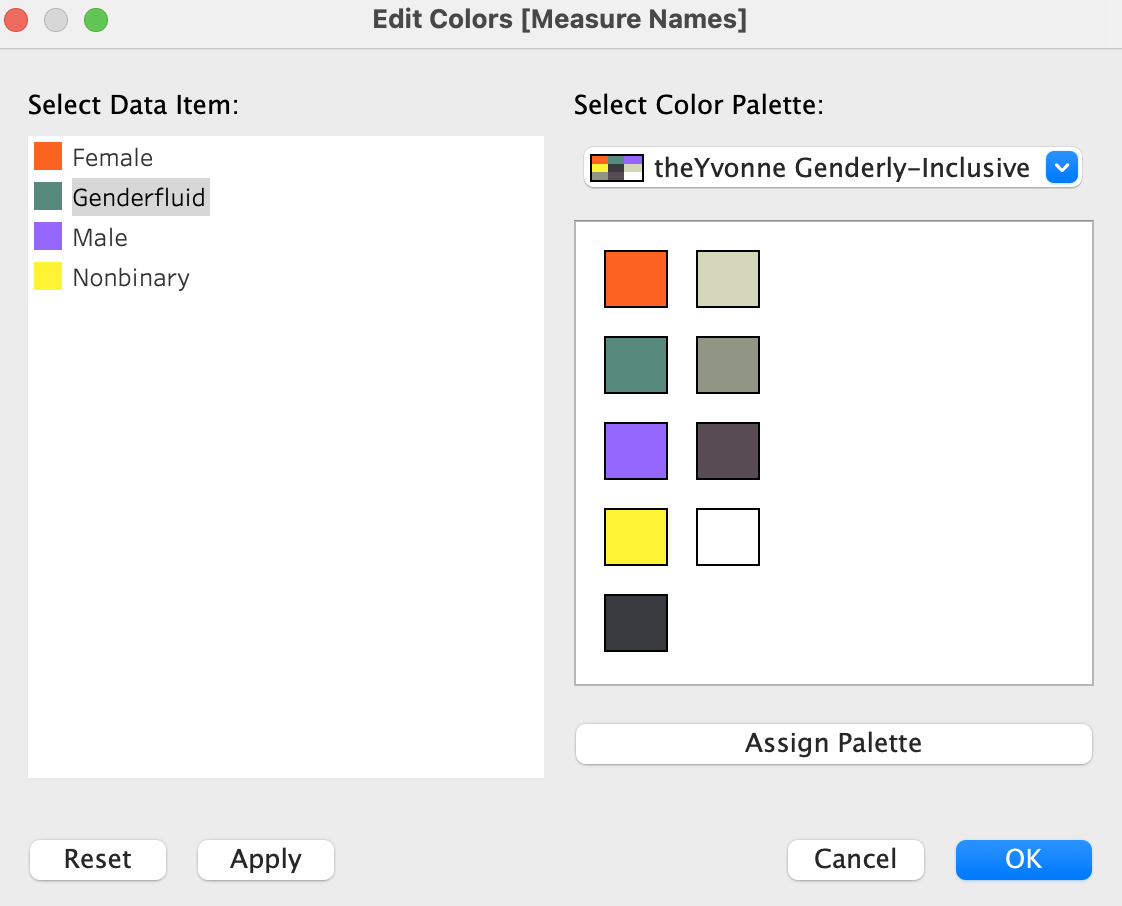Genderly - Gender Inclusive Palette
Palette Details
| Female | #FD6320 | Orange Red |
| Genderfluid | #58897D | Wintergreen Dream |
| Male | #9567FE | Medium Slate Blue |
| Non-binary | #FEF433 | Cadmium Yellow |
| Title | #3A3B40 | Onyx |
| Line | #D4D6B9 | Pale Spring Bud |
| Footer | #919584 | Artichoke |
| Text | #584B53 | Dark Liver |
| Background Viz | #FFFFFF | White |
| Background Chart | #D4D6B9 | Pale Spring Bud 25 % Opacity |
Reading time: 2 min 19 secs
Usage
Helpful in showing data with a gender grouping - Female, Genderfluid, Male, and Non-binary
Description
For visualizations using gender information, my default palette was Genderly. The Genderly palette represents two genders - females (#FD6320 Orange Red) and males (#9567FE Medium Slate Blue). I selected these specific colors to avoid the blue/pink combo and the bias those colors convey. However, this palette is not inclusive.
I haven't done any viz which needed an extended gender list, but that did not mean I couldn't update the palette to be more inclusive proactively today. While researching this topic, I found a long list of different gender categories. Non-binary and Genderfluid were the two additional genders seen most often. I believe emerging data sets will incorporate these two additional options as time passes. I will keep evaluating and updating this palette as time continues to be inclusive.
In creating the "Genderly - Inclusive" color palette, I kept the color representing females (#FD6320 Orange Red) and males (#9567FE Medium Slate Blue) the same to maintain a consistent look with my past work and original palette. This selection also reflects a trend in visualization to have females be an orange-ish color and males represented in a purple-ish color. My research did not uncover a color trend for representing Non-binary and Genderfluid data.
For inspiration for my selections for these additional gender categories, I examined the pride flag colors used to represent both groups, which I found on Wikipedia. The Non-Binary Flag feature Cadmium Yellow #FEF433. This color was distinctive and would work in a data viz. Therefore, I have selected Cadmium Yellow #FEF433 to be used in the expanded color palette to represent Non-Binary Data.
In reviewing the flag for Gender Fluid, I removed the pink and blue colors to avoid confusion with the blue/pink gender assumptions and representation of the past. I removed the black and white since these colors can be used for backgrounds and text, thus limiting the use of the palette. The remaining color was purple. Since my past work used a purple color for males and the trend today in the data visualization community is to use purple for males, I also eliminated purple as an option to avoid confusion for the viewers. This process left me with no colors from the Gender Fluid Flag. I needed a color, not in the orange/red, purple, yellow, pink, and blue families. I wanted some connection to their flag; maybe a color leaning toward black but not black would be essential in the selection. I found Wintergreen Dream (#58897D), a lovely dark green color. This color is the one I have selected to represent Genderfluid data.
I will keep monitoring trends to see what the data viz community selects over time. But, for now, I am pleased I have a gender-inclusive palette for any future data work that uses gender breakout categories. These two new colors worked well with the color I previously selected in the original Genderly Palette for text, backgrounds, and titles.
Tableau Palette Code
Add the code snippet to your Preferences.tps, an XML file found in your Documents directory's My Tableau Repository folder. I typically place it above the </preferences> tag at the end. But, again, you can use a text or XML editor.
Tableau Code Snippet
<color-palette name="theYvonne Genderly-Inclusive" type="regular" >
<color>#FD6320</color>
<color>#58897D</color>
<color>#9567FE</color>
<color>#FEF433</color>
<color>#3A3B40</color>
<color>#D4D6B9</color>
<color>#919584</color>
<color>#584B53</color>
<color>#FFFFFF</color>
</color-palette>
Preferences.tps Example File
Reference
Example Viz For Original Genderly Viz
Please note I still need to do a viz that needs an Inclusive Palette. However, I did not want to wait for the need to arise to be inclusive, so I updated the original palette.
What do you think? Let me know on Twitter @YvonFitz.
Related Post You Might Enjoy








